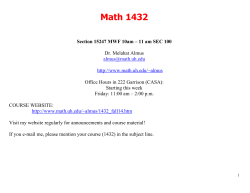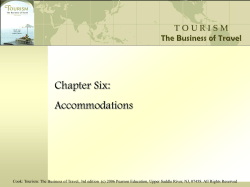
Unit #23 : Unconstrained Optimization Goals:
Unit #23 : Unconstrained Optimization Goals: • Learn how to find critical points algebraically. • Classify critical points using the second derivative test. • Solve a number of optimization problems. Reading: Sections 15.1, 15.2. Unit 23 - Page 2 of 25 Detecting Local Extrema Algebraically Local Extrema and Critical Points If the function f (x, y) is differentiable at (a, b) (so that it has a gradient vector) and f has a local maximum or minimum at (a, b), then grad f (a, b) =< 0, 0 >. A point where grad f (a, b) =< 0, 0 > is called a critical point. [See H-H, beginning of Section 15.1.] Unit 23 - Page 3 of 25 Example: Consider the function f (x, y) = x4 + y 4 − 4xy. Find the location of the critical points of f (x, y). Unit 23 - Page 4 of 25 The contour diagram shown below is for the previous function. Label each critical point as a local min, max or neither. Unit 23 - Page 5 of 25 We notice that one of the critical points is neither a local max nor min. What does this type of critical point look like in a surface? Unit 23 - Page 6 of 25 Saddle Points Critical points that are not a local maximum or minimum are most commonly saddle points. Unit 23 - Page 7 of 25 Saddle Point A point (a, b) of a function f (x, y) is a saddle point if • It is a critical point of f and • It is a crossing of two contour lines • The surface is shaped like a saddle around the critical point: concave up in one direction, concave down in another. Illustration of a saddle point: 1 y –1 –0.5 0.5 0 0.5 x –0.5 –1 1 Unit 23 - Page 8 of 25 Example: On the following contour diagram, mark the • local maxima • local minima • saddle points • global maximum (on the domain shown) • global minimum (on the domain shown) Unit 23 - Page 9 of 25 3 9 11 13 1 12 16 15 8 12 1 14 3 10 11 12 2 9 10 14 11 10 7 9 6 9 10 11 5 8 0 9 87 9 10 9 6 11 10 8 5 6 4 3 2 −2 8 3 8 7 6 −1 5 4 9 10 8 7 6 7 −3 −3 −2 −1 0 1 2 3 Unit 23 - Page 10 of 25 3 9 11 13 1 12 16 15 8 12 1 14 3 10 11 12 2 9 10 14 11 10 7 9 6 9 10 11 5 8 0 9 87 9 10 9 6 11 10 8 5 6 4 3 2 −2 8 3 8 7 6 −1 5 4 9 10 8 7 6 7 −3 −3 −2 −1 0 1 2 3 Unit 23 - Page 11 of 25 Determining the Type of Critical Point Analytically In single variable functions, we tested whether a critical point was a local min or local max using the first or second derivative tests. The first derivative test cannot be easily extended to multiple dimensions. Explain why there is a difficulty in multiple dimensions. Instead, we will use an extension of the Second Derivative Test, which relates to the concavity around a critical point. Unit 23 - Page 12 of 25 Second Derivative Test Suppose (a, b) is a critical point of f . Let D = fxx(a, b) · fyy (a, b) − (fxy (a, b))2 (a) If D > 0 and fxx(a, b) > 0, then (a, b) is a minimum. (b) If D > 0 and fxx(a, b) < 0, then (a, b) is a maximum. (c) If D < 0, then (a, b) is a saddle point. (d) If D = 0, then the test fails. Cases: 2.5 0 2 –0.5 1.5 –1 1 –1.5 0.5 –2 –1 1 –1 1 –0.5 0.5 00 y x 0.5 1 –0.5 0.5 x 0.5 –1 1 y –1 Unit 23 - Page 13 of 25 Example: Identify the critical points of the function f (x, y) = 3x2y + y 3 − 3x2 − 3y 2 then use the second derivative test to identify which are local maxima and minima. Unit 23 - Page 14 of 25 Are the local maxima and minima also the global maxima and minima? Explain your answer. Unit 23 - Page 15 of 25 Applications Example: A closed rectangular box has volume 100 cm3. What are the lengths of the edges giving the minimum surface area? Show that your answer is at least a local minimum. (You do not need to show it is a global minimum.) Unit 23 - Page 16 of 25 Example: A company operates two plants which manufacture the same item and whose total cost functions are C1 = 8.5 + 0.03q12 and C2 = 5.2 + 0.04q22 where q1 and q2 are the quantities produced by each plant. The total quantity demanded, q = q1 + q2, is related to the price, p, by p = 60 − 0.04q What is the total cost to the company of producing q1 and q2 units? Unit 23 - Page 17 of 25 What is the gross revenue to the company of producing q1 and q2 units? Unit 23 - Page 18 of 25 Give a formula for the net profit, as a function of q1 and q2. Unit 23 - Page 19 of 25 Use critical points to identify the values of q1 and q2 that maximize the profit. Show that your answer is a local maximum. Unit 23 - Page 20 of 25 Example: Find the point on the plane 5z + 2x + y = 2 which is closest to the origin. Use the second derivative test to confirm that your value is a local minimum for the distance. Unit 23 - Page 21 of 25 In single-variable calculus, if a continuous function had only one critical point and it was a local minimum, then that minimum was also a global minimum. Try to sketch a one-variable function with a local minimum and no other critical points, but which does not have a global minimum. Unit 23 - Page 22 of 25 In multi-variate calculus, the range of surfaces we can define is very broad, and it becomes more difficult to support simple assertions about global maxima and minima. Example: Consider the function f (x, y) = x2(1 − y)3 + y 2 Find the critical points of f . 1 From the Section 15.2 problems. 1 Unit 23 - Page 23 of 25 f (x, y) = x2(1 − y)3 + y 2 Show that the only critical point is a local minimum. Unit 23 - Page 24 of 25 f (x, y) = x2(1 − y)3 + y 2 Is the local minimum we found a global minimum? Why or why not? Unit 23 - Page 25 of 25 Support your answer referring to the surface and contour diagrams of f (x, y) = x2(1 − y)3 + y 2 shown below. 3 100.5−1 0 1 10 −100.51 2 2 4 8 6 −−180 −64 − −2 .5 −0 −10 −−8 −46 − −0.52 4 2 0 1 2 1 1 1 1 5 1 0.5 0.5 1 2 4 6 8 10 1 0.5 2 0 0 8 4 10 5 6 0. 1 −5 4 6 2 8 −1 4 −6 −4 8 10 10 −10 −6 1 2 −4 −2 0 −2 6 −2 0 2 2 4 8 4 6 6 −3 −3 −2 −1 0 1 2 3
© Copyright 2025





















